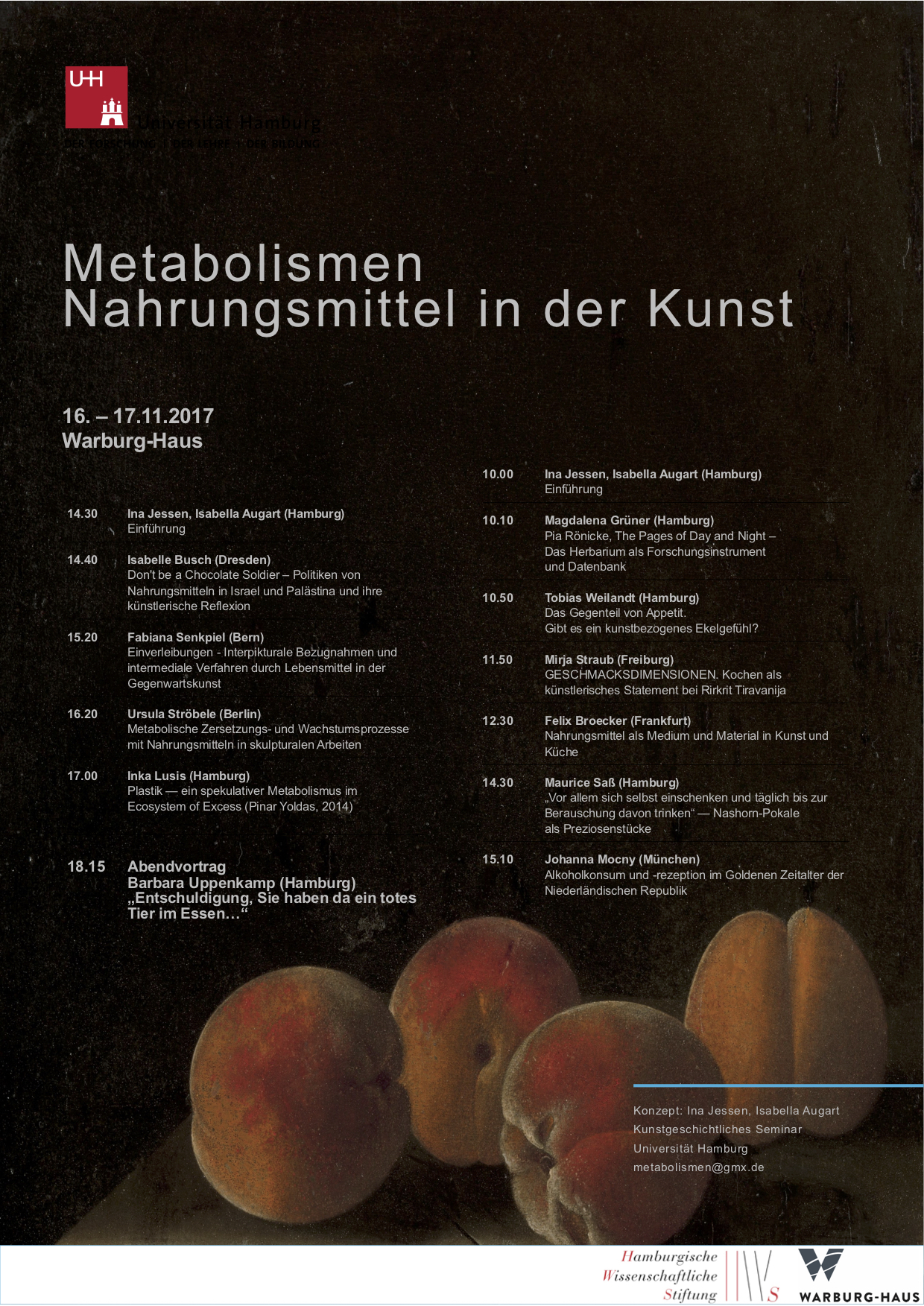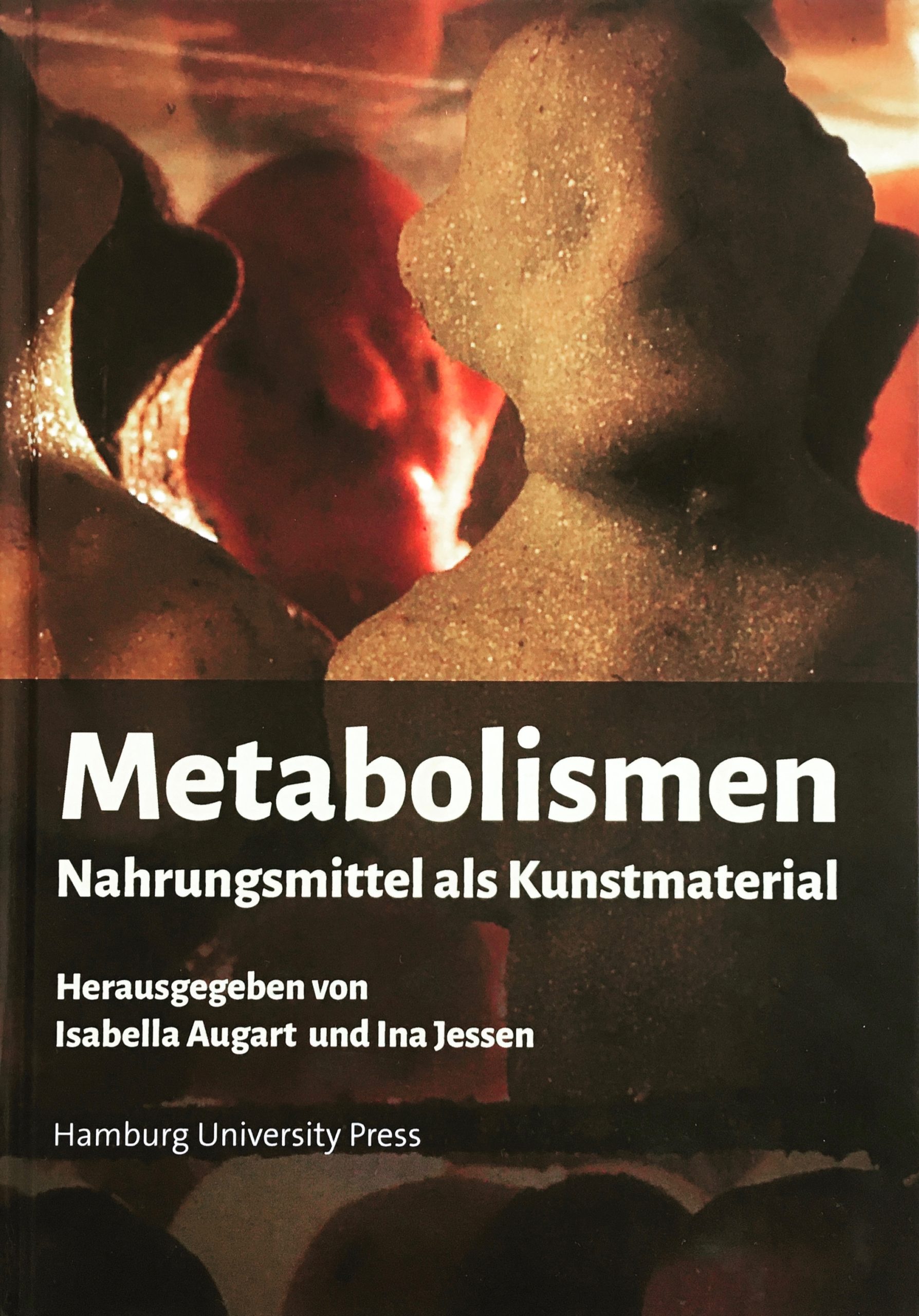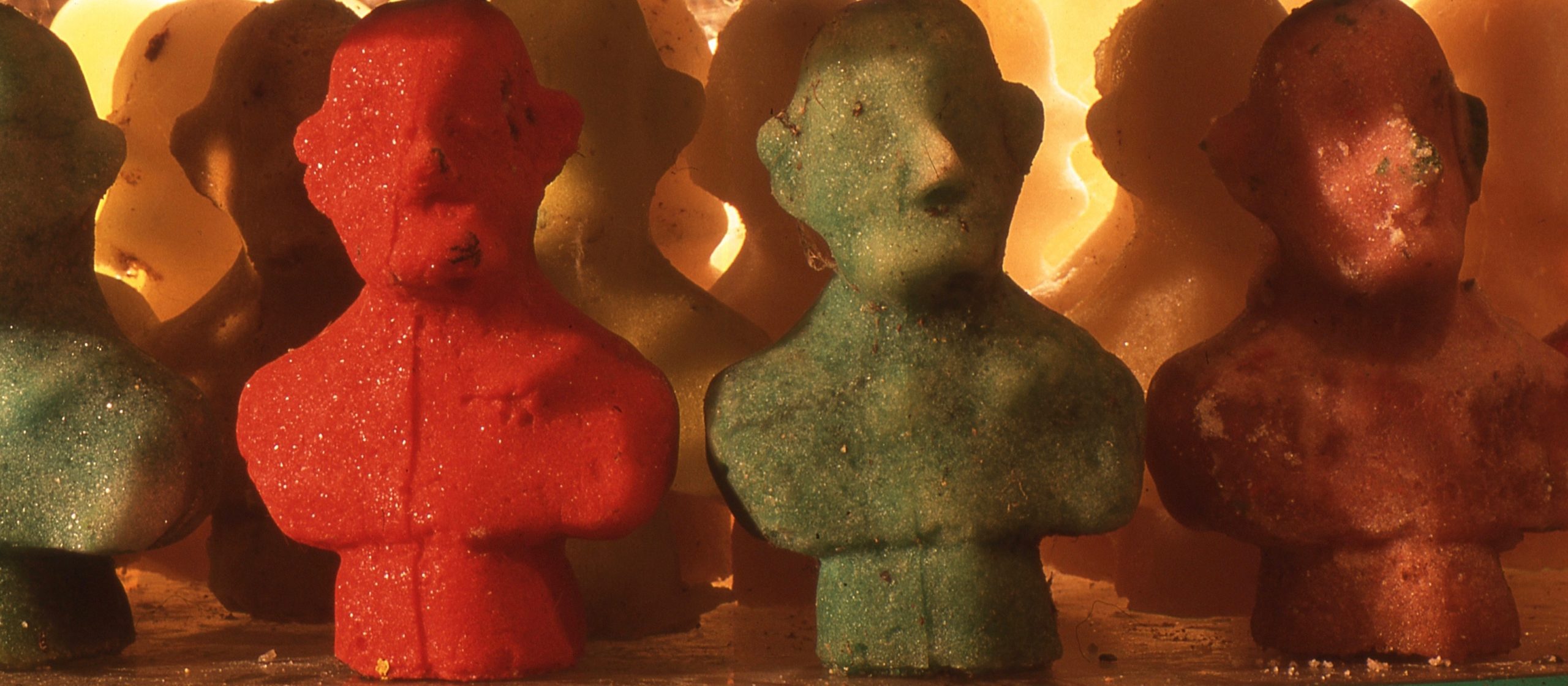Metabolisms. Food in Art
International symposium
Organised by: Dr. Isabella Augart and Dr. des. Ina Jessen
Art History Seminar (UHH) · Warburg House · Dieter Roth Museum
On 16 and 17 November 2017, the workshop Metabolisms. Food in Art took place in cooperation between the Dieter Roth Museum and the Warburg-Haus (Department of Art History, University of Hamburg). On both days, scientific and curatorial aspects and perspectives were contextualised in relation to the materiality of artworks. Against the backdrop of art historical and cultural contexts, the participants focused on food as material and motif as well as the respective metabolisms, understood as “metabolism”, between real processes of decay up to culturally variable measurements of value. Origin and transience, aggregate and ripeness states of food as organic material as well as the associated aesthetic and sensual stimuli in the history of art and culture represented the central themes in the examination of the materiality of food as a material and motif of representation in artistic practice between the Baroque and the present.At the start of the event, the ephemeral food works of the artist were brought into view in the Dieter Roth Museum and the multifaceted field of workshop topics was opened in terms of content based on an object-oriented discussion in the small group. In this way, in addition to the content-related prelude, it was also possible to create the discursive and collaborative basis for a productive cooperation between the lecturers, which was then continued in the context of the lectures in the Warburg House.
The international origins and global interweavings associated with food production point to aspects and conflicts that are as global as they are political, social, economic and ecological. These can be significant for a work of art or the iconology of a material or the creation of an object. Isabelle Busch addressed corresponding political levels in her contribution Don’t be a Chocolate Soldier – Politics of Food in Israel and Palestine and their Artistic Reflection, in which she negotiated works of different national localisation in an exhibition to be shown in Germany. She posed the question of how the circuits of food in global structures can be mediated in curatorial terms. With the example of Israeli and Palestinian conflicts over culinary traditions, which are shown in artistic works by Larissa Sansour, for example, Isabelle Busch opened a discussion that was both topical and lively.
In her lecture Einverleibungen – Interpikturale Bezugnahmen und intermediale Verfahren durch Lebensmittel in der Gegenwartskunst (Incorporations – Interpictural References and Intermedial Processes through Food in Contemporary Art), Fabiana Senkpiel spoke about constructions of meaning of food as a material in art and the extent to which these shape an art object. With the concept of Einverleibung, she placed interpictural and intermedial image relations in relation to each other and also recurred to reception-specific causal connections. Contemporary aesthetic practices and medial approaches through and with food, exemplified by the positions of the Swiss artists Isabelle Krieg and Celia and Nathalie Sidler, were of central importance in the lecture and plenary discussion.
Material specifics in the sense of work-immanent transformation processes are significant in the context of the use of food in artistic works. They focus on the processuality of the material, for example with regard to the respective semantics and iconology. In her contribution Metabolic Decomposition and Growth Processes with Food in Sculptural Works, Ursula Ströbele took a look at different metabolic processes and their significance for the consideration of the respective objects. Materials of different aggregate states, such as excreted liquids that have already undergone the metabolic process, represent her object of analysis. In this context, she examines the respective artistic handling and also spans ethical and environmental contexts.
Inka Lusis spoke about visionary aspects in her lecture Plastic – a speculative metabolism in the Ecosystem of Excess about Pinar Yoldi’s work of the same name from 2014. Exploring the material plastic as food is relevant both from a physical, metabolic point of view and in view of ecological processes. The current eco- and biopolitical discourses resulting from this were a guiding aspect in this context.
The evening lecture – for which we were able to win Barbara Uppenkamp – took a look at the architecture of the Hamburg Central Slaughterhouse in the 19th and 20th centuries with the title Excuse me, you have a dead animal in your food. In addition to the curatorial, meaning- and material-specific as well as visionary-based questions of the day, a bridge was thus built to the production conditions of food and thus a basic prerequisite of metabolic processes of art was pointed out.
In the lectures of the second day, patterns of order and efforts at categorisation were first elaborated with regard to food. In her lecture Pia Rönicke, Magdalena Grüner explained how questions about the collection, categorisation and preservation of plants, about shifts between natural products and cultivated cultural goods and about political negotiations of food, access to resources and food diversity come together in the herbarium, the collection of preserved plants and plant parts. The Pages of Day and Night – The Herbarium as a Research Tool and Database. With a view to colonial history as a research tool, she presented a contemporary position that exposes the current handling of seeds and plants from Syria and other theatres of war that are worthy of protection.
Healthy and unhealthy, tasty and tasteless – the human view of the diversity of food can be further sharpened in the order pattern appetising and disgusting. Disgust is generally regarded as a defensive reaction against mouldy and spoiled food and against decomposition processes. In his lecture, Tobias Weilandt dealt with the question “Is there an art-related feeling of disgust?”
References between art and gastronomy were uncovered in another section of the workshop. Mirja Straub dealt with Rikrit Tiravanija, who, as an artist chef, cooks in front of and for viewers in galleries and art associations, lets them taste and thereby lets them themselves become part of his artistic practice. In her lecture GESCHMACKSDIMENSIONEN. Cooking as an Artistic Statement by Rikrit Tiravanija, she discussed the historical, social and cultural dimensions for each of the artist’s food choices and recipes, from Thai PadThai to Swabian Flädlesuppe.
In his lecture Food as Medium and Material in Art and Cuisine, Felix Bröcker presented the visual staging of food in art and in high-end gastronomy in various positions of the 20th and 21st centuries. Materiality and material change fascinate in both areas and become controllable and usable through cultural techniques. Using food as an example, he showed how art and cuisine depict social changes and value assessments of food, such as locality, luxury or originality.
Transformations of the human being or the artist were discussed in the last block of the workshop. Maurice Saß dealt with the materiality of tableware made from the horn of rhinoceroses in his contribution, Above all, pour yourself a drink and drink to intoxication – rhinoceros goblets as precious pieces. The status of the exotic animal played a role in courtly festivities, as did the sculptural treatment and the pharmaceutical significance of the animal material. Finally, the last speaker, Johanna Mocny, dealt with intoxication as a dimension of metabolism. In her contribution, she showed how closely the art of drinking and art were connected in the Baroque era, alcohol consumption and reception in the Golden Age of the Dutch Republic on the basis of glasses and other evidence of material culture, illustrations in wine-growing and beer-brewing textbooks, art literature and pictorial works.The workshop was concluded with a joint discussion of the term “metabolisms”. The relevance of the question of “metabolisms” in the materiality, material semantics and material transformation of food in art was illustrated by the historical as well as current positions presented in an object-oriented approach. The speakers made it clear to what extent the term “metabolism” in the individual artistic positions discussed encompasses, firstly, the biological sense dimension of “metabolism” in the context of (human) food intake and food utilisation as a basic condition of life, secondly, it conceptualises the “metabolism” of the (artistic) material itself between growth, ripening, decay and putrefaction on the one hand, and between preparation (cooking, distilling, frying) on the other, and thirdly, it also helps to understand the cultural, historical and social dimension of values, taste dimensions and patterns of order applied to food.


Dieter Roth, Zuckerturm (Schimmelmuseum), 1994. Fotografie: Heini Schneebeli, 1999
© Dieter Roth Foundation, Hamburg / Courtesy, Hauser & Wirth.
